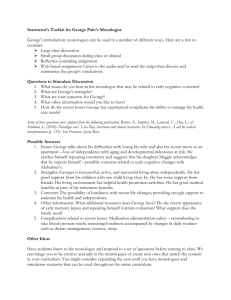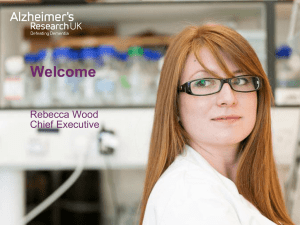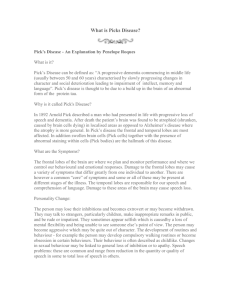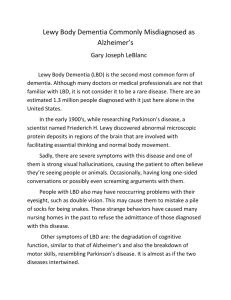Understanding Dementia - Daughters of Sarah Senior Community
advertisement
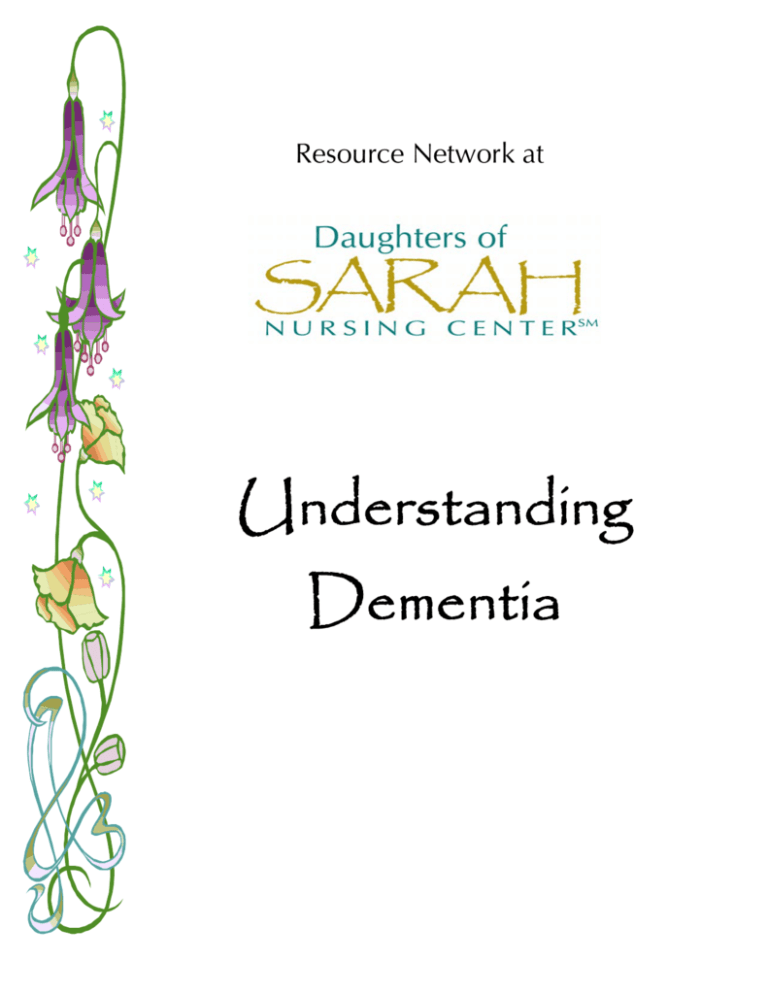
Resource Network at Understanding Dementia What is Dementia? Dementia is a disease in which a progressive decline occurs in memory, thinking abilities, personality and behavior. There are over 50 causes of Dementia but the most common cause of Dementia in older people is Alzheimer’s disease. Between 50 and 70 percent of all people with dementia are suffering from Alzheimer’s disease. Common Behavioral Problems ¾ ¾ ¾ ¾ ¾ ¾ ¾ ¾ ¾ ¾ ¾ ¾ Anger/Agitation Sleep Disturbances Paranoia/Delusions Eating/Feeding Problems Dressing Incontinence Wandering Screaming Repetitive Actions Refusing to Bathe Wanting to go Home Sundowning Many disorders can cause dementia. There are other disorders that can cause dementia such as, Parkinson’s disease, stroke, Pick’s disease, Huntington’s disease, and Creutzfeldt – Jacob disease Alzheimer’s Disease: Alzheimer’s Dementia is a degenerative brain disease that occurs when nerve cells (neurons) in the outer layer of the brain (the cortex) die. The disease affects memory and mental functioning (e.g. thinking and speaking, etc.), but can also lead to other problems such as confusion, changes in mood and personality and disorientation in time and space. The disease affects people both under and over 65 years of age but is more common in those over 65. Those who develop the illness before the age of 65 years are often described as having Early Onset Alzheimer’s disease. First Stage Symptoms of Alzheimer’s (years leading up to and including diagnosis) · Less ability to adapt to changes in life · Problems making decisions or avoidance of responsibility · Loss of concentration · Forgetful, confused or moody · Depression · Upset and frustrated at one’s own decline in abilities. Examples: Forgets to pay bills, phone numbers and items on grocery list. Difficulty driving a car; cooking/following recipe and maintaining a checkbook. Second Stage Symptoms of Alzheimer’s · · · · · · · (2 – 10 years after diagnosis) Forgetful of recent events or people’s · Disorientated and lost (wandering names streets) Confused about time, day and place · Hide or lose things and accuse others of stealing them Inability to recognize familiar · Auditory or visual hallucinations surroundings Difficulty talking and often repeating · Easily angry, upset or aggressive oneself Inability to comprehend what is said · Problems with reading, writing, and numbers Difficulties with household tasks and · Needs full-time supervision personal hygiene Suffer with severe depression Examples: Not able to cook, dress, bathe and cook and giving money to strangers. Third Stage Symptoms of Alzheimer’s · Unable to remember things previously · · · · · said or did Inability to recognize family members or familiar objects Unable to express oneself (i.e.: may groan or scream) Can not find the right words, makes up stories Difficulty understanding anything that is said Restless during the night · Try to carry out actions or re-live events from the past · Unable to carry out personal hygiene tasks without supervision · Loss of control of bladder then bowel function · Confined to a wheelchair or bed · Delusions and hallucinations · Needs full-time supervision Examples: Can’t remember visitors/visits; Repetitive movements, statements, tapping or folding; Sleep often during day and frequently awake at night. Some difficulty getting into a chair; Can’t find the right words, “I used to be a big boss man and now I’m a big old dummy.”; Problems reading and math. Suspicious/may accuse spouse/family of hiding things or of infidelity. Genetic Factors/Heredity In an extremely small number of families Alzheimer’s disease is a dominant genetic disorder. Members of such families inherit from one of their parents the part of the DNA (the genetic make-up), which causes the disease. Types of Dementia: · Stroke. A stroke occurs when the blood supply to part of the brain is suddenly interrupted or when a blood vessel in the brain bursts, spilling blood into the spaces surrounding brain cells. Brain cells die when they no longer receive oxygen and nutrients from the blood or there is sudden bleeding into or around the brain. The symptoms of a stroke include sudden numbness or weakness, especially on one side of the body; sudden confusion or trouble speaking or understanding speech; sudden trouble seeing in one or both eyes; sudden trouble with walking, dizziness, or loss of balance or coordination; or sudden severe headache with no known cause. There are two forms of stroke: ischemic – blockage of a blood vessel supplying the brain, and hemorrhagic – bleeding into or around the brain. · Pick’s Disease Pick’s disease is a progressively degenerative neurological disease similar to Alzheimer’s Disease for which there is no known prevention, or cure. Pick’s Disease affects the frontal and temporal lobes first, with earliest symptoms showing up as changes in personality and a decline in function at home as well as work. Pick’s Disease is frequently first diagnosed as stress or depression and then as Alzheimer’s disease. The treatment of Pick’s Disease is the same as for various stages of other dementias such as Alzheimer’s. The disease usually affects individuals between the ages of 40 and 60, the age of onset may range from 20 to 80. · Lewy Body Dementia. Lewy bodies are microscopic protein deposits found in deteriorating nerve cells. They often appear in areas deep within the brain and are associated with the tremor and rigidity of Parkinson’s disease. When widespread within the brain, Lewy bodies cause signs and symptoms similar to those of Alzheimer’s disease. Unlike Alzheimer’s, though, Lewy body dementia may affect speed of thinking, attention and concentration, and visual spatial abilities more severely than memory and language. It can also cause hallucinations and large fluctuations in degree of alertness. · Parkinson’s Disease. People with Parkinson’s disease may experience stiffness of limbs, shaking at rest (tremors), speech impairment and a shuffling gait. Some people with Parkinson’s develop dementia late in the disease. This type of dementia begins with a slowing of the thought processes and difficulty concentrating and eventually progresses to confusion. · Huntington’s Disease. This disease stems from an inherited disorder that causes certain nerve cells within the brain to waste away. As the disorder progresses, a person with Huntington’s develops personality changes and a decline in intellect, memory, speech and judgment. Dementia commonly develops in the later stages of the disease. · Creutzfeldt-Jakob Disease. This rare and fatal brain disorder can occur in young or middle-aged people. Creutzfeldt-Jakob disease is thought to be the result of prions, infectious agents that can transform normal protein molecules into transmissible, deadly ones. The earliest signs and symptoms of the disease are usually memory impairment and behavioral changes. The disease usually progresses rapidly with mental deterioration, muscle jerking (involuntary movements), weakness in the arms or legs, blindness and eventually coma. Brain Functions and Map Cerebral Cortex: Frontal Lobe: Most anterior, right under the forehead. Functions: · How we know what we are doing within our environment (Consciousness) · How we initiate activity in response to our environment. · Judgments we make about what occurs in our daily activities. · Controls our emotional response. · Controls our expressive language. · Assigns meaning to the words we choose · Involves word associations. · Memory for habits and motor activities. Observed Problems: · Loss of simple movement of various body parts (Paralysis) · Inability to plan a sequence of complex movements needed to complete multi-stepped tasks, such as making coffee (Sequencing) · Loss of spontaneity in interacting with others. · Loss of flexibility in thinking · Persistence of a single thought (Perseveration) · Inability to focus on task (Attending). · Mood changes (Emotionally Labile). · Changes in social behavior. · Changes in personality. · Difficulty with problem solving. · Inability to express language (Broca’s Aphasia) Parietal Lobe: Near the back and top of the head. Functions: · Location for visual attention. · Location for touch perception. · Goal directed voluntary movements. · Manipulation of objects. · Integration of different senses that allows for understanding a single concept. Observed Problems: · Inability to attend to more than one object at a time. · Inability to name an object (Anomia). · Inability to locate the words for writing (Agraphia). · Problems with reading (Alexia). · Difficulty with drawing objects. · Difficulty in distinguishing left from right. · Difficulty with doing mathematics (Dyscalculia). · Lack of awareness of certain body parts and/or surrounding space (Apraxia) that leads to difficulties in self-care. · Inability to focus visual attention. · Difficulties with eye and hand coordination. Occipital Lobes: Most posterior, at the back of the head. Function: Vision Observed Problems: · Defects in vision (Visual Field Cuts). · Difficulty with locating objects in environment. · Difficulty with identifying colors (Color Agnosia). · Production of hallucinations. · Visual illusions – inaccurately seeing objects. · Word blindness – inability to recognize words. · Difficulty in recognizing drawn objects. · Inability to recognize the movement of an object (Movement Agnosia). · Difficulties with reading and writing. Temporal Lobes: Side of head above ears. Functions: · Hearing ability. · Memory acquisition. · Some visual perceptions. · Categorization of objects. Observed Problems: · Difficulty in recognizing faces (Prosopagnosia). · Difficulty in understanding spoken words (Wernicke’s Aphasia). · Disturbance with selective attention to what we see and hear. · Difficulty with identification of, and verbalization about objects. · Short-term memory loss · Interference with long-term memory · Increased or decreased interest in sexual behavior. · Inability to categorize objects (Categorization). · Right lobe damage can cause persistent talking. · Increased aggressive behavior. Brain Stem: Deep in Brain, leads to spinal cord. Functions: · Breathing · Heart Rate · Swallowing · Reflexes to seeing and hearing (Startle Response). · Controls sweating, blood pressure, digestion, temperature (Autonomic Nervous System). · Affects level of alertness · Ability to sleep · Sense of balance (Vestibular Function). Observed Problems: · Decreased vital capacity in breathing, important for speech. · Swallowing food and water (Dysphagia). · Difficulty with organization/perception of the environment. · Problems with balance and movement. · Dizziness and nausea (Vertigo). · Sleeping difficulties (insomnia, sleep apnea). Cerebellum: Located at the base of the skull. Functions: · Coordination of voluntary movement. · Balance and equilibrium. · Some memory for reflect motor acts. Observed Problems: · Loss of ability to coordinate fine movements. · Loss of ability to walk. · Inability to reach out and grab objects. · Tremors. · Dizziness (Vertigo). · Slurred Speech (Scanning Speech). · Inability to make rapid movements. How to Communicate with a Person with Dementia • Approach the person from the front slowly. • Eye contact at face to face level • Identify yourself by name • Call the person by name • Use nonverbal communication • Relaxed body language • Give brief, one line sentences • Allow time for recognition and response • Repeat yourself, if necessary and if helpful. • Make close-ended statements rather than asking questions (i.e., It is a beautiful, sunny day. Let’s take a walk. Avoid questions such as “what did you have for lunch?”). Helping the Person Communicate • • • • • • • Be calm and supportive. Maintain eye contact and use touch to reassure him/her and show that you are listening. Show interest in what he/she is saying or feeling. Pay attention to his/her voice and gestures for clues to what he/she is feeling. Sometimes, his/her emotions are more important than what he/she is trying to say. If you don’t understand what she is trying to say, encourage her to point or gesture. If he cannot find a word, he may be less frustrated if you offer a guess. If she uses the wrong word and you know what she means, supply the correct word. If this upsets her, do not correct future mistakes. If he is upset and cannot explain verbally, offer comfort and reassurance. Trying to get him to explain may make him more upset. Helping the Person Understand • • • • • • • • • • • • • • Approach from the front but be aware that some people feel more comfortable if you talk from a handshake away. Keep confusion, noise and distraction to a minimum. Begin each conversation by identifying yourself and addressing her by name to orient her and get her attention. Speak slowly and distinctly. Use a lower voice pitch to convey a sense of calm. Tone of voice is as important as the words because the person can sense emotions. Use short, simple, familiar words and sentences. Explain your actions and break tasks into clear steps, giving one step at a time. Ask one question at a time and give time to respond. Repeat questions or information using same words and phrasing as before. Talk in positive terms. Avoid giving direct orders. Demonstrate your request by drawing, pointing at or touching things. Use names when referring to other individuals, instead of “he” or “she”. Treat him with dignity and respect. He is an adult. Use nonverbal communication, a smile or hug, to reinforce verbal communication.



